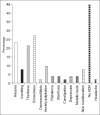Status of disulfiram in present day alcoholic deaddiction therapy
- PMID: 21431004
- PMCID: PMC3056183
- DOI: 10.4103/0019-5545.75557
Status of disulfiram in present day alcoholic deaddiction therapy
Abstract
Aim: Assessment of safety and efficacy profile of disulfiram (DSM) in the alcoholic de-addiction regimen.
Objectives: a. Assessment of Adverse Drug Reaction (ADR) profile; b. Evaluation of effectiveness of various deaddiction regimen; c. Defaulters and dropouts
Patients and methods: Fifty-one patients in a de-addiction center were investigated on 0(th) , 30(th) and 60(th) day along with psychiatric evaluation, ADR surveillance was made. Statistical analysis was done thereafter.
Results: 125 mg DSM given OD for 2 months. 76.5% patients had taken full course of treatment, 45% didn't complain of any ADR. Of ADR reported 27.4% had drowsiness, 21.4% tiredness, 7.8% skin manifestation.
Conclusion: DSM is the main drug among naltrexone, acamprosate, nalmefene and other drugs used in alcoholic de-addiction. Relative and effectiveness is lost by the degree of dropouts and hence relapses. Low-dose DSM had decreased adverse effects with 76.5% patients taking the full course of treatment. DSM alters liver functions as there were significant changes in the lab parameters of SGPT(P=0.007), SGOT(P=0.001), GGT(P=<0.001) between first and third samples. Occurrence of ADR is not the cause of default; patients find it confusing to differentiate between the symptoms of alcohol withdrawal and those due to ADR of DSM.
Keywords: Adverse drug reaction; alcohol de-addiction; de-addiction regimen; disulfiram; drug default.
Conflict of interest statement
Figures










Similar articles
-
Disulfiram therapy--adverse drug reactions and interactions.Acta Psychiatr Scand Suppl. 1992;369:59-65; discussion 65-6. doi: 10.1111/j.1600-0447.1992.tb03317.x. Acta Psychiatr Scand Suppl. 1992. PMID: 1471554
-
Pharmacological treatment of alcohol dependence: a review of the evidence.JAMA. 1999 Apr 14;281(14):1318-25. doi: 10.1001/jama.281.14.1318. JAMA. 1999. PMID: 10208148
-
Naltrexone and disulfiram in patients with alcohol dependence and comorbid post-traumatic stress disorder.Biol Psychiatry. 2006 Oct 1;60(7):777-83. doi: 10.1016/j.biopsych.2006.03.074. Biol Psychiatry. 2006. PMID: 17008146 Clinical Trial.
-
Pharmacotherapy of alcohol dependence: a review of the clinical data.CNS Drugs. 2004;18(8):485-504. doi: 10.2165/00023210-200418080-00002. CNS Drugs. 2004. PMID: 15182219 Review.
-
Personalized Medicine of Alcohol Addiction: Pharmacogenomics and Beyond.Curr Pharm Biotechnol. 2017;18(3):221-230. doi: 10.2174/1389201018666170224105025. Curr Pharm Biotechnol. 2017. PMID: 28240173 Review.
Cited by
-
Alcohol Abstinence, Adherence, and Attitudes toward Disulfiram Treatment for Alcohol Dependence among Patients Attending a Tertiary Care Setting in North India.Addict Health. 2024 Jul;16(3):152-158. doi: 10.34172/ahj.1537. Epub 2024 Jul 29. Addict Health. 2024. PMID: 39439855 Free PMC article.
-
Pharmacotherapy for relapse prevention of alcohol use disorder in the Indian setting: A systematic review.Ind Psychiatry J. 2018 Jul-Dec;27(2):163-171. doi: 10.4103/ipj.ipj_79_17. Ind Psychiatry J. 2018. PMID: 31359967 Free PMC article. Review.
-
Surreptitious Administration of Disulfiram Along with Its Implantation Leading to Disulfiram-associated Encephalopathy.Indian J Psychol Med. 2025 May;47(3):302-304. doi: 10.1177/02537176241236710. Epub 2024 Mar 25. Indian J Psychol Med. 2025. PMID: 39564333 Free PMC article. No abstract available.
-
Safety and Tolerability of Pharmacological Treatment of Alcohol Dependence: Comprehensive Review of Evidence.Drug Saf. 2016 Jul;39(7):627-45. doi: 10.1007/s40264-016-0416-y. Drug Saf. 2016. PMID: 27023898 Review.
-
Disulfiram inhibits liver fibrosis in rats by suppressing hepatic stellate cell activation and viability.BMC Pharmacol Toxicol. 2022 Jul 22;23(1):54. doi: 10.1186/s40360-022-00583-5. BMC Pharmacol Toxicol. 2022. PMID: 35864505 Free PMC article.
References
-
- De Souza Avinash. Studies of family supervised disulfiram, naltrexone and acamprosate in the Indian setting. 2006. Proceedings of 3rd Berlin Stapleford International Addiction Conference on latest developments in effective medical treatments for addiction; Berlin March 18 - 19th avinashdes999@yahoo.com .
-
- Christensen JK, Rønsted P, Vaag UH. Side effects after disulfiram: Comparison of disulfiram and placebo in a double-blind multicentre study. Acta Psychiatr Scand. 1984;69:265–73. - PubMed
-
- Borup C, Kaiser A, Jenson E. Long term antabuse treatment: Tolerance and reasons for withdrawal. Acta Psychiatr Scand Suppl. 1992;369:47–9. - PubMed
-
- Enghusen Poulsen H, Loft S, Andersen JR, Andersen M. Disulfiram therapy--adverse drug reactions and interactions. Acta Psychiatr Scand Suppl. 1992;369:59–65. - PubMed
LinkOut - more resources
Full Text Sources
Research Materials
Miscellaneous

